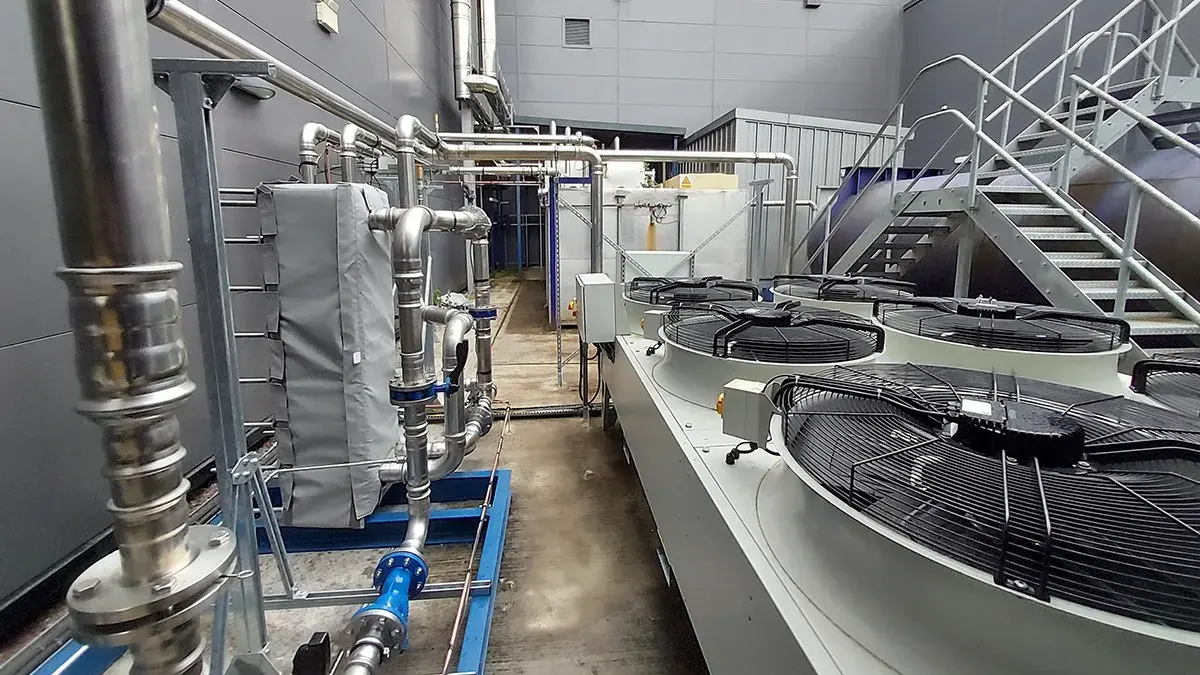While water plays a vital role in cooling systems for vacuum furnaces, maintaining its quality is often overlooked. Poor water quality can lead to scaling, corrosion, and other issues that force your system to work harder, driving up energy costs. Water treatment isn't a low priority maintenance task—it's a critical factor that can drastically improve energy efficiency and operational performance. By addressing water quality, you can achieve significant energy savings and enhance the lifespan of your equipment.
Here we’ll explore how proper water treatment directly impacts energy efficiency and helps reduce your carbon footprint. We'll cover the common issues that arise from untreated water, such as scaling and corrosion, and explain the components of water that require treatment. Additionally, we'll discuss key signs that indicate issues with water quality and share essential maintenance tips to ensure your cooling system operates at peak efficiency.
Water quality pitfalls: issues and impacts on cooling efficiency
Maintaining water quality is crucial for the efficient operation of vacuum furnace cooling systems. Poor water quality can lead to various issues that impair cooling performance, increase energy consumption, and reduce equipment lifespan. Below are some common problems and their impact on cooling efficiency:
Scaling
Scaling occurs when minerals like calcium and magnesium in the water form deposits on the cooling system's internal surfaces. These deposits act as an insulating layer, reducing heat transfer efficiency and forcing the furnace cooling system to consume more energy. Over time, scaling can also restrict water flow, leading to overheating and potential damage to key components.
Corrosion
Corrosion happens when untreated water, containing dissolved oxygen or carbon dioxide, attacks metal components in the cooling system. This weakens the system's structural integrity, leading to leaks, equipment failure, and expensive repairs. Corrosion can also reduce efficiency if the integrity of critical components such as pipes, valves and heat exchangers is compromised, allowing coolant to leak out and/or air to enter the system.
Microbial Growth
Cooling systems can become breeding grounds for bacteria, algae, and other microorganisms if water is untreated. Microbial growth can form biofilms that insulate surfaces, reducing heat transfer efficiency. Over time, these organisms can cause blockages, increase corrosion, and contaminate the system, ultimately leading to energy inefficiencies and maintenance challenges.
Fouling
Fouling occurs when contaminants such as suspended solids like sand or other debris, organic matter, or biological growth accumulate on heat exchange surfaces. This buildup reduces heat transfer efficiency, forces the system to work harder, and increases energy consumption. If left untreated, fouling can lead to overheating and potential breakdowns in the cooling system.
Freezing
Freezing can occur in cooling systems when water temperature drops below its freezing point, especially in colder climates. As water freezes, it expands, potentially leading to pipe bursts, blockages, and significant damage to components such as air blast coolers. Freezing not only risks equipment failure but also disrupts the cooling system’s efficiency, as blocked or damaged lines impair water flow and heat transfer.
Treating your water…
Effective water treatment is crucial for maintaining the efficiency of your cooling system and preventing issues discussed above. By implementing the right treatment methods, equipment’s performance can be restored. Below are some of the key water treatment methods to ensure optimal water quality.
Filtration
Filtration is a crucial first step in water treatment, removing suspended solids and particulate matter from the cooling water. By physically filtering out contaminants like sand, silt, and debris, filtration helps to prevent fouling, ensures smooth water flow, and maintains the efficiency of heat transfer within the cooling system. Clean water allows the system to operate at peak performance, reducing energy consumption. Filtration can be achieved using mechanical filters, such as mesh or cartridge filters, which should be regularly inspected and cleaned or replaced.
Chemical treatment
Chemical treatment involves the addition of specific chemicals, such as scale inhibitors, corrosion inhibitors, and biocides, to the water. These chemicals actively combat issues like scaling, corrosion, and microbial growth. By maintaining the water's chemical balance, the system remains protected from damage, prolonging equipment life and ensuring that energy usage is kept at an optimal level. Chemical dosing systems can be installed to automatically add the appropriate chemicals to the water based on periodic water quality testing.
Softening
Water softening is the process of removing hardness-causing minerals, like calcium and magnesium, and replacing them with sodium ions. This prevents the formation of scale on heat exchanger surfaces and cooling system components, maintaining efficient heat transfer. Softened water minimizes energy waste, as the system doesn’t need to work harder to overcome the insulating effects of scale buildup. Softening can be done through ion exchange systems, where resin beads swap calcium and magnesium ions with sodium ions.
pH control
Maintaining the correct pH level in cooling water is essential to prevent both corrosion and scale formation. If water is too acidic, it can corrode metal components, leading to leaks and inefficiencies. Conversely, overly alkaline water can cause scaling. Regular pH monitoring and adjustments keep the system running smoothly, helping to reduce energy costs and prevent costly repairs. Automated pH control systems can be used to add acids or bases to the water to keep the pH within the desired range.
Deaeration
Deaeration is the process of removing dissolved gases, particularly oxygen and carbon dioxide, from the cooling water. These gases can accelerate corrosion, weakening the system's structural integrity over time. Deaeration can be achieved through mechanical means or chemical additives, ensuring the water remains non-corrosive and extending the lifespan of the equipment. Deaeration can be done by using deaerators or adding oxygen scavengers like sodium sulphite to the water.
Frost inhibitors
Frost inhibitors play a critical role in preventing the cooling system from freezing in colder environments. These inhibitors, typically glycol-based, lower the freezing point of the water, ensuring that it remains liquid and continues to circulate, even in sub-zero temperatures. By preventing freezing, frost inhibitors protect the system from damage such as burst pipes and pump failure. In addition to this, many frost inhibitors contain corrosion inhibitors that help protect metal components from rust. Ensuring the right concentration of frost inhibitors in the water treatment system is crucial for maintaining operational efficiency during colder months.
Lookout for….
- Visible rust may signal improper pH or high dissolved oxygen in the water.
- A rise in pressure drop could point to blockages from scale, solids, or biofilm.
- Strange sounds or vibrations may indicate the presence of air pockets or scaling. Air pockets form due to small leaks or dissolved gases released when water heats up, while scaling creates resistance to water flow. Both conditions cause turbulence, leading to unusual noise and vibrations.
- Longer cooling times or higher than normal energy consumption of the cooling system can indicate scaling or fouling. These buildups block efficient heat transfer, forcing the system to work harder and run longer to achieve the same cooling effect, resulting in increased energy consumption and reduced system performance.
- Reduced water flow in parts of the system may indicate rust or scale buildup. Scaling or corrosion can accumulate in key areas like heat exchangers or piping, restricting flow and reducing cooling efficiency.
Maintenance tips for water-cooling systems:
1. Regular Water TestingRoutinely test the cooling water for pH, hardness, and contaminants. This helps identify issues like scaling or corrosion early, allowing for timely corrective actions.
2. Monitor and adjust pH levels
Keep the water’s pH within the recommended range to prevent corrosion and scaling. Use pH adjusters as needed.
3. Inspect for scaling and corrosion
Regularly check cooling pipes and equipment for signs of scaling or rust. If detected, perform chemical descaling or corrosion treatment to protect the system.
4. Clean and replace filters
Ensure that filters in the system are cleaned or replaced periodically to prevent the buildup of particulates that can cause fouling and reduce efficiency.
5. Regular chemical treatment
Use corrosion inhibitors, scale inhibitors, and biocides as part of your maintenance routine to control microbial growth and protect against rust and scaling.
6. Check for air pockets
High points of the cooling system may have the potential to trap air, reducing cooling efficiency. Ensure air is bled from any such identified locations.
7. Inspect and maintain deaeration equipment
Ensure that air separators / eliminators are functioning correctly to remove gases from the system.
8. Flush the system periodically
Perform chemical flushes to clean out any rust, scale, or biological buildup that may have accumulated, ensuring optimal water flow and heat transfer.
At VFE, we provide comprehensive and tailored cooling system maintenance services including water treatment to keep your cooling system performing at optimum efficiency. Don’t let water quality or cooling system performance issues undermine your equipment efficiency and lifespan. Contact our experts today to learn how solutions can enhance your system’s performance and restore lost efficiency.
Click here to book a consultation or call us directly at +44 (0)1384 426170 to discuss your water treatment needs.

